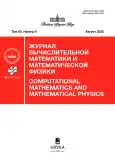Volume 65, Nº 8 (2025)
General numerical methods
SPECTRAL METHODS AND QUADRATURES
Resumo
 1303–1317
1303–1317


Optimal control
Controllability of a Linear Stationary System Given the Bounded Control Norm
Resumo
 1318–1327
1318–1327


Partial Differential Equations
On Time-Global Solvability of One Cauchy Problem for a Nonlinear Equation of Composite Type of the Heat-Electric Model
Resumo
 1328-1350
1328-1350


 1351-1372
1351-1372


Mathematical physics
RANS Simulation of Supersonic Flow of a Cylinder Fixed Between Parallel Plates
Resumo
 1373–1386
1373–1386


On Preserving Spherical Symmetry on a Spherical Grid in the Cartesian Coordinate System When Calculating Gas-Dynamic Currents by Euler Finite-Volume Schemes
Resumo
 1387–1396
1387–1396


Simultaneous Identification of the Thermal Conductivity and Volumetric Heat Capacity of a Substance in the Three-Dimensional Case
Resumo
 1397-1407
1397-1407


Solution to contact problem between an elastic body and a rigid base covered with a layer of deformable material
Resumo
 1408–1422
1408–1422


Non-viscous instability of a boundary layer over the compliant surface at supersonic speeds of the incoming flow
Resumo
 1423–1435
1423–1435


Laws of Symmetry of Dynamic Processes in Media with Films
Resumo
 1436–1442
1436–1442


Computer science
On the Complexity of Realizating Logical Supervised Classification Procedures
Resumo
 1443–1450
1443–1450


ACOUSTIC WAVEFORM INVERSION WITH IMAGE-TO-IMAGE SCHRODINGER BRIDGES
Resumo
Recent developments in application of deep learning models to acoustic Full Waveform Inversion (FWI) are marked by the use of diffusion models as prior distributions for Bayesian-like inference procedures. The advantage of these methods is the ability to generate high-resolution samples, which are otherwise unattainable with classical inversion methods or other deep learning-based solutions. However, the iterative and stochastic nature of sampling from diffusion models along with heuristic nature of output control remain limiting factors for their applicability For instance, an optimal way to include the approximate velocity model into diffusion-based inversion scheme remains unclear, even though it is considered an essential part of FWI pipeline. We address the issue by employing a Schrodinger Bridge that interpolates ¨ between the distributions of ground truth and smoothed velocity models. Thus, the inference process that starts from an approximate velocity model is guaranteed to arrive at a sample from the distribution of reference velocity models in a finite time. To facilitate the learning of nonlinear drifts that transfer samples between distributions and to enable controlled inference given the seismic data, we extend the concept of Image-to-Image Schrodinger Bridge (I ¨ 2SB) to conditional sampling, resulting in a conditional Image-to-Image Schrodinger Bridge (cI ¨ 2SB) framework for acoustic inversion. To validate our method, we assess its effectiveness in reconstructing the reference velocity model from its smoothed approximation, coupled with the observed seismic signal of fixed shape. Our experiments demonstrate that the proposed solution outperforms our reimplementation of conditional diffusion model suggested in earlier works, while requiring only a few neural function evaluations (NFEs) to achieve sample fidelity superior to that attained with supervised learning-based approach. The supplementary code implementing the algorithms described in this paper can be found in the repository https://github.com/stankevich-mipt/seismic_inversion_via_
 1451–1466
1451–1466











